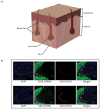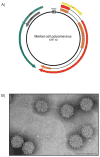Merkel cell polyomavirus: a newly discovered human virus with oncogenic potential
- PMID: 23217622
- PMCID: PMC3522868
- DOI: 10.1016/j.virol.2012.09.029
Merkel cell polyomavirus: a newly discovered human virus with oncogenic potential
Abstract
A marked escalation in the rate of discovery of new types of human polyomavirus has occurred over the last five years largely owing to recent technological advances in their detection. Among the newly discovered viruses, Merkel Cell Polyomavirus (MCPyV or MCV) has gained the most attention due to its link with a rare human cancer. Infection with MCPyV is common in the human population, and the virus is detected in several anatomical locations, but most frequently in skin. Study of MCPyV molecular virology has been complicated by the lack of straightforward cell culture models, but recent in vitro studies are making strides towards understanding the virus life cycle, its cellular tropism, and mode of transmission. While MCPyV shares several traditional traits with other human polyomaviruses, the burst of research since its discovery reveals insight into a virus with many unique genetic and mechanistic features. The evidence for a causal link between MCPyV and the rare neuroendocrine cancer, Merkel Cell Carcinoma (MCC), is compelling. A majority of MCCs contain clonally integrated viral DNA, express viral T antigen transcripts and protein, and exhibit an addiction to the viral large T and small t antigen oncoproteins. The MCPyV large T antigen contains MCC tumor-specific mutations that ablate its replication capacity but preserve its oncogenic functions, and the small t antigen promotes an environment favorable for cap-dependent translation. The mechanisms of MCPyV-induced transformation have not been fully elucidated, but the likely etiological role of this new polyomavirus in human cancer provides a strong opportunity to expand knowledge of virus-host interactions and viral oncology.
Copyright © 2012 Elsevier B.V. All rights reserved.
Figures



Similar articles
-
Merkel cell polyomavirus and non-Merkel cell carcinomas: guilty or circumstantial evidence?APMIS. 2020 Feb;128(2):104-120. doi: 10.1111/apm.13019. Epub 2020 Jan 28. APMIS. 2020. PMID: 31990105 Review.
-
Infectious Entry of Merkel Cell Polyomavirus.J Virol. 2019 Mar 5;93(6):e02004-18. doi: 10.1128/JVI.02004-18. Print 2019 Mar 15. J Virol. 2019. PMID: 30626687 Free PMC article.
-
Merkel Cell Polyomavirus Infection of Animal Dermal Fibroblasts.J Virol. 2018 Jan 30;92(4):e01610-17. doi: 10.1128/JVI.01610-17. Print 2018 Feb 15. J Virol. 2018. PMID: 29167345 Free PMC article.
-
Merkel cell polyomavirus infection, large T antigen, retinoblastoma protein and outcome in Merkel cell carcinoma.Clin Cancer Res. 2011 Jul 15;17(14):4806-13. doi: 10.1158/1078-0432.CCR-10-3363. Epub 2011 Jun 3. Clin Cancer Res. 2011. PMID: 21642382
-
Merkel cell carcinoma: a virus-induced human cancer.Annu Rev Pathol. 2012;7:123-44. doi: 10.1146/annurev-pathol-011110-130227. Epub 2011 Sep 13. Annu Rev Pathol. 2012. PMID: 21942528 Free PMC article. Review.
Cited by
-
Identification of episomal human papillomavirus and other DNA viruses in cytological anal samples of HIV-uninfected men who have sex with men.PLoS One. 2013 Aug 12;8(8):e72228. doi: 10.1371/journal.pone.0072228. eCollection 2013. PLoS One. 2013. PMID: 23951299 Free PMC article.
-
Tumorigenic activity of merkel cell polyomavirus T antigens expressed in the stratified epithelium of mice.Cancer Res. 2015 Mar 15;75(6):1068-79. doi: 10.1158/0008-5472.CAN-14-2425. Epub 2015 Jan 16. Cancer Res. 2015. PMID: 25596282 Free PMC article.
-
Cancer-testis antigens as biomarkers for Merkel cell carcinoma: Pitfalls and opportunities.J Cutan Pathol. 2019 Oct;46(10):748-752. doi: 10.1111/cup.13528. Epub 2019 Jul 11. J Cutan Pathol. 2019. PMID: 31218705 Free PMC article.
-
Gut microbiota: Role and Association with Tumorigenesis in Different Malignancies.Mol Biol Rep. 2022 Aug;49(8):8087-8107. doi: 10.1007/s11033-022-07357-6. Epub 2022 May 11. Mol Biol Rep. 2022. PMID: 35543828 Review.
-
Merkel cell polyomavirus large T antigen binding to pRb promotes skin hyperplasia and tumor development.PLoS Pathog. 2022 May 13;18(5):e1010551. doi: 10.1371/journal.ppat.1010551. eCollection 2022 May. PLoS Pathog. 2022. PMID: 35560034 Free PMC article.
References
-
- Agelli M, Clegg LX. Epidemiology of primary Merkel cell carcinoma in the United States. J Am Acad Dermatol. 2003;49:832–841. - PubMed
-
- Ahuja D, Saenz-Robles MT, Pipas JM. SV40 large T antigen targets multiple cellular pathways to elicit cellular transformation. Oncogene. 2005;24:7729–7745. - PubMed
-
- Albores-Saavedra J, Batich K, Chable-Montero F, Sagy N, Schwartz AM, Henson DE. Merkel cell carcinoma demographics, morphology, and survival based on 3870 cases: a population based study. Journal of cutaneous pathology. 2010;37:20–27. - PubMed
-
- Andres C, Belloni B, Puchta U, Sander CA, Flaig MJ. Prevalence of MCPyV in Merkel cell carcinoma and non-MCC tumors. Journal of cutaneous pathology. 2010;37:28–34. - PubMed
-
- Andres C, Ihrler S, Puchta U, Flaig MJ. Merkel cell polyomavirus is prevalent in a subset of small cell lung cancer: a study of 31 patients. Thorax. 2009;64:1007–1008. - PubMed
Publication types
MeSH terms
Substances
Grants and funding
LinkOut - more resources
Full Text Sources
Other Literature Sources
Medical
Miscellaneous

